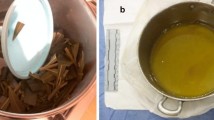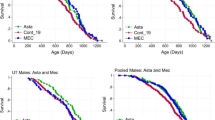Summary
Light- and electron microscopic alterations of the liver and light microscopic findings in the gastro intestinal tract, the kidney and adrenal gland of 80 female Wistar-Rats under CDCA therapy are reported. CDCA was applied by means of an endopharyngeal tube over a period of 60 days in doses of 150, 250, 500 and 1000 mg/kg body weight. The organs were examined at different times. We compared the achieved findings to results obtained already beforehand by light- and electron microscopy after application of 20, 50 and 90 mg/kg body weight and day: Up to a dosage of 90 mg/kg morphological changes of the liver were only visible electron optically, from 150 mg/kg onward they could be seen light optically as well. After 60 days a cirrhosis-like picture had developed. The lethal dose was established at 1000 mg/kg. There were no pathological alterations in the gastrointestinal tract and no definite ones in the kidneys. The adrenal glands were unchanged.—Since there are in the rats, in spite of potent mechanisms of detoxication of CDCA and LCA, even at low doses morphological alterations to be seen, the existence of other toxic, at this moment still unknown metabolites is being discussed.
Zusammenfassung
Es wird über licht- und elektronenmikroskopische Veränderungen an der Leber und über lichtmikroskopische Befunde am Magen-Darmtrakt, der Niere und Nebenniere 80 weiblicher Wistar-Ratten unter Chenodesoxycholsäure (CDC) berichtet. CDC wurde in Dosen von 150, 250, 500 und 1000 mg/kg Körpergewicht über 60 Tage durch eine Schlundsonde appliziert. Die Organe wurden zu verschiedenen Zeitpunkten untersucht. Die erhobenen Befunde setzten wir zu früheren licht- und elektronenmikroskopischen Ergebnissen nach Gabe von 20, 50 und 90 mg/kg und Tag in Beziehung: Bis zu einer Dosis von 90 mg/kg ließen sich morphologische Veränderungen an der Leber nur elektronenmikroskopisch, ab 150 mg/kg auch lichtoptisch erfassen. Nach 60 Tagen hatte sich ein einer Zirrhose ähnliches Bild entwickelt. Die Dosis letalis lag bei 1000 mg/kg. — Am Magen-Darmtrakt fanden wir keine pathologischen Veränderungen, an den Nieren keine sicheren. Die Nebennieren waren unauffällig. — Da die Ratte trotz leistungsfähiger Entgiftungssysteme für Lithocholsäure und Chenodesoxycholsäure bereits bei niedrigen Dosen morphologische Veränderungen erkennen läßt, wird das Vorkommen anderer toxischer, z. Z. noch unbekannter Metaboliten diskutiert.
Similar content being viewed by others
Literatur
Bergman, F., Van der Linden, W.: Liver morphology and gallstone formation in hamsters and mice treated with chenodeoxycholic acid. Acta path. microbiol. scand. Sect. A,81, 213 (1973)
Borowsky, S. A., Bonorris, G. G., Goldstein, L. I., Schoenfield, L. J.: Effects of chenodeoxycholic and lithocholic acids on hamster liver ultrastructure. Digest. Disease Week, A. 19. S. Francisco, May 1974
Carey, J. B., Wilson, I. D., Zaki, F. G., Hanson, R. F.: The metabolism of bile acids with special reference to liver injury. Medicine45, 461 (1966)
Czygan, P., Stiehl, A.: Untersuchungen zur Toxizität sulfatierter und nicht sulfatierter Lithocholsäure. Z. Gastroenterologie12, 436 (1974)
Dawson, A. M., Isselbacher, K. J.: Studies on lipid metabolism in the small intestine with observations on the role of bile salts. J. Clin. Invest.39, 730 (1960)
Dyrszka, H., Chen, T., Salen, G., Mosbach, E. H.: Toxicity of chenodeoxycholic acid in the rhesus monkey. Gastroenterology69, 333 (1975)
Fischer, C. D., Cooper, N. S., Rothschild, M. A., Mosbach, E. H.: Effect of dietary chenodeoxycholic acid and lithocholic acid in the rabbit. Digestive Diseases19, 877 (1974)
Fisher, M. M., Magnusson, R., Phillips, M. J., Miyai, K.: Bile acid metabolism in mammals. IV. Sex difference in chenodeoxycholic acid metabolism in the rat. Lab. Invest.27, 254 (1972)
Fisher, M. M., Magnusson, R., Miyai, K.: Bile acid metabolism in mammals. I. Bile acidinduced intrahepatic cholestasis. Lab. Invest.21, 88 (1971)
Fromm, H., Holz-Slomczyk, M., Zobl, H., Schmidt, E., Schmidt, F. W.: Studies of liver function and structure in patients with gallstones before and during treatment with chenodeoxycholic acid. Acta hepatogastroent.22, 359 (1975)
Hamza, K. N., DenBesten, L.: Bile salt producing stress ulcer during experimental shock. Surgery71, 161 (1972)
Heywood, R., Palmer, A. K., Foll, C. V., Lee, M. R.: Pathological changes in fetal rhesus monkey induced by oral chenodeoxycholic acid. Lancet1973 II, 1021
Hofmann, A. F., Paumgartner, G.: Chenodeoxycholic acid therapy of gallstones. Stuttgart-New York: F. K. Schattauer 1975
Hofmann, A. F.: Pathogenesis and dissolution of cholesterol gallstones. 80. Tgg. Dtsch. Ges. Inn. Med., Wiesbaden, 22.–25. 4. 1974
Holsti, P.: Zirrhogene Einwirkung von Gallensäurenverbindungen. Naturwiss.45, 165 (1958)
Holsti, P.: Cirrhosis of the liver induced in rabbits by gastric instillation of 3-monohydroxycholanic acid. Nature186, 250 (1960)
Hsia, S. L.: Taurochenodeoxycholic acid 6β-hydroxylase system of rat liver. In: Bile salt metabolism, eds. L. Schiff, J. B. Carey, J. M. Dietschy, p. 103. Illinois (USA), 1969
James, O., Scheuer, P. T., Bouchier, I. A. D.: The effect of chenodeoxycholic acid on liver function and histology in man. Digestion8, 432 (1973)
Kuschinsky, G., Lüllmann, H.: Kurzes Lehrbuch der Pharmakologie, S. 56. Stuttgart: G. Thieme 1970
Leuschner, U., Neuenfeldt, H. U.: Elektronenmikroskopische Untersuchungen an der Rattenleber nach oraler Applikation von Chenodesoxycholsäure. Z. Gastroenterologie13, 27 (1975)
Leuschner, U., Jöck, C.: Morphologische, tierexperimentelle Untersuchungen zur Frage geschlechtsspezifischer Leberschäden durch Chenodesoxycholsäure. Z. Gastroenterologie15, 29 (1977)
Leuschner, U., Neuenfeldt, H. U.: Licht- und elektronenmikroskopische Untersuchungen am Magen-Darm-Trakt der Ratte nach oraler Gabe von Chenodesoxycholsäure. Z. Gastroenterologie13, 648 (1975)
Leuschner, U., Reber, E., Erb, W.: Erfahrungen bei der Behandlung von Gallensteinträgern mit Chenodesoxycholsäure. Dtsch. Med. Wschr.102, 156 (1977)
Leuschner, U., Czygan, P., Stiehl, A.: Licht- und elektronenmikroskopische Untersuchungen zur Toxizität von sulfatierter und nichtsulfatierter Lithocholsäure. Dtsch. Ges. Inn. Med. Verhbd.81, 1311 (1975)
Liersch, M., Stiehl, A.: Bildung von Gallensäurensulfatestern in perfundierten Rattenlebern nach Gallengangsverschluß. Z. Gastroenterologie12, 131 (1974)
Low-Beer, T. S., Schneider, R. E., Dobbins, W. O.: Morphological changes of the small intestinal mucosa of guinea pig and hamster following incubation in vitro and perfusion in vivo with unconjugated bile salts. Gut11, 486 (1970)
Miyai, K., Price, V. M., Fisher, M. M.: Bile acid metabolism in mammals. Ultrastructural studies on the intrahepatic cholestasis induced by lithocholic and chenodeoxycholic acids in the rat. Lab. Invest.24, 292 (1971)
Morrissey, K. P., Mc Scherry, Ch. K., Swarm, R. L., Niemann, W. H., Deitrick, J. E.: Toxicity of chenodeoxycholic acid in the nonhuman primate. Surgery77, 851 (1975)
Paget, G. E., Barnes, J. M.: Toxicity Tests. In: Evaluation of Drug Activities: Pharmacometrics, eds. D. R. Laurence, A. L. Bacharach, Vol. 1, p. 161. London-New York: Academic Press 1964
Palmer, A. K., Heywood, R.: Pathological changes in the rhesus fetus associated with the oral administration of chenodeoxycholic acid. Toxicology2, 239 (1974)
Palmer, R. H., Hruban, Z.: Production of bile duct hyperplasia and gallstones by lithocholic acid. J. Clin. Invest.45, 1255 (1966)
Palmer, R. H.: Bile acid sulfates: II. Formation, metabolism, and excretion of lithocholic acid sulfates in the rat. J. Lipid Res.12, 680 (1971)
Priestly, B. G., Côté, M. G., Plaa, G. L.: Biochemical and morphological parameters of taurolithocholate-induced cholestasis. Canad. J. Physiol. Pharmacol.49, 1078 (1971)
Shiner, M.: Bile salt metabolism, ed. L. Schiff, p. 41. Illinois (USA): J. B. Carey, J. M. Dietschy 1969
Stiehl, A., Raedsch, R., Kommerell, B.: Increased sulfation of lithocholate in patients with cholesterol gallstones during chenodeoxycholate treatment. Digestion12, 105 (1975)
Stiehl, A., Raedsch, R., Regula, M., Kommerell, B.: Zur Behandlung von Patienten mit Cholesteringallensteinen mit Chenodesoxycholsäure: Veränderungen im Gallensäurenstoffwechsel. Inn. Med.2, 13 (1975)
Teem, M. V., Phillips, S. F.: Perfusion of the hamster jejunum with conjugated and unconjugated bile acids: inhibition of water absorption and effects on morphology. Gastroenterology62, 261 (1972)
Autor nicht genannt: Toxicity of chenodeoxycholic acid in rhesus monkeys. Lancet1974 II, 1517 (Letter)
Thistle, J. L., Hofmann, A. F., Ott, B. J., Yu, P. Y. S.: Gallstone dissolution with chenodeoxycholic acid, 1969–1976: The Mayo Clinic Studies. Gastroenterology (im Druck)
Thomas, P. J., Hsia, S. L., Matschiner, J. Z., Doisy, E. A., Elliot, W. H., Thayer, S. H., Doisy, E. A.: Bile acids XIX metabolism of lithocholic acid-24-14C in the rat. J. Biol. Chem.239, 102 (1964)
Webster, K. H., Lancaster, M. C., Wease, D. F., Hofmann, A. F., Baggenstoss, A. H.: The effect of primary bile acid feeding on cholesterol metabolism and hepatic function and morphology in the rhesus monkey. Gastroenterology65, A-52/576 (1973)
WHO-Technical Report Series No. 563. Herausgegeben von der Weltgesundheitsorganisation 1975, ed. Cantor, Aulendorf i. Württemberg
Zaki, F. G., Carey, J. B., Hoffbauer, F. W., Nwokolo, Ch.: Biliary reaction and choledocholithiasis induced in the rat by lithocholic acid. J. Lab. Clin. Med.69, 737 (1967)
Author information
Authors and Affiliations
Additional information
Auszugsweise vorgetragen auf dem 10. Internationalen Kongreß für Gastroenterologie, Budapest, 23.–29. 6. 1976
Die Untersuchungen wurden durch die Harry-und-Peter-Fuld-Stiftung unterstützt
Rights and permissions
About this article
Cite this article
Leuschner, U., Schneider, M., Loos, R. et al. Morphologische Untersuchungen zur Toxizität oral verabreichter Chenodesoxycholsäure an Leber, Magen-Darmtrakt, Niere und Nebenniere der Ratte. Res. Exp. Med. 171, 41–55 (1977). https://doi.org/10.1007/BF01851587
Received:
Issue Date:
DOI: https://doi.org/10.1007/BF01851587




